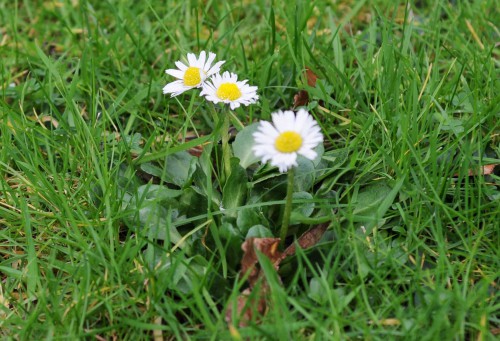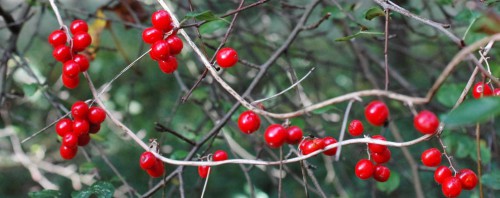Tags
daisy, gorse, hart's tongue fern, hazel catkins, lesser celandine, male fern, wildflowers blooming in January, winter heliotrope, winter wildflowers
Daisies look delicate, but they’re tough little plants and flower more-or-less continuously from December to January. I love them so am happy they can decorate grassy areas in peace before the lawn-mowers emerge from hibernation.
Celandines are one of the first heralds of Spring, but I was taken by surprise to find some this early in the year.
Herb Robert was also a surprise, its flowering season is more April-November, so this is probably a plant that has not died down and carried on growing.
Another survivor is this Nipplewort which is growing in a sheltered corner against a wall on the roadside.
There are some wildflowers that are truly winter flowering. The bright green leaves of Winter heliotrope are present here throughout the year and the lilac flowers, which have a fragrant, vanilla-like scent appear from November to March.
January 26th was a mild sunny day, warm enough to coax out this little Red-tailed bumblebee, but it seemed to be struggling to take off from the flower, so maybe it wasn’t quite warm enough.
Three-cornered Garlic is named for the shape of its flower stems, which are triangular. It is also known as White bluebell and does resemble one, until you smell it. It’s flowering season is February- June but has been in flower here since last December.
“When gorse is out of bloom, kissing is out of season“. In other words, gorse pretty much flowers all year round to some extent. Now, at the end of this mild January many bushes are well-covered with the lusciously coconut-scented blossom.
Hazel catkins have also been present on some trees since last month.
A few trees have retained their dried leaves for some reason, this is a small oak.
Some plants characteristically hang on to their berries well into the winter, one such is the unfortunately-named Stinking iris that has bright orange berries
and another is Black bryony, whose bright scarlet berries garland shrubs like strings of shiny beads.
A surprising number of ferns are still green
Both the Male fern and the Hart’s Tongue fern are semi-evergreen, but this group shows no sign of dying down at all.
Winter is a good time to appreciate mosses. Looking closely at this one it has fern-like leaves.
On a fallen Scots pine a colony of tiny bright yellow coloured fungi has established itself; it seems to be a bracket fungi, maybe a turkeytail?






















One of the thing that surprised me most about the flora of Southern Spain was the familiarity of many wildflowers, even if they are a slightly different species, at least you know where to start. I love the early spring there when all the bulbous flowers familiar in UK gardens bloom wild in the woods. You’re lucky to have the bumblebees, they’re not that common in Spain – it’s too warm for them!
LikeLike
Lots to see here in your post and some very familiar ones to our woodland in Southern Spain. The white tailed bumblebees have been quite busy here but it does get a bit warmer when the sun shines.
LikeLike
Lovely post. I didn’t know the name of the Herb Robert and we have a lot of it in our garden so I’m most grateful about that, thanks. Could it be honey-fungus on the tree?
LikeLike
Thank you Val, I’m glad you’ve kept the Herb Robert in your garden, lots of people think of it as a ‘weed’, but it’s so pretty. I’m not great on fungi, but I think honey fungus grows like more of a cluster of mushroom shapes- I need to go back and have another look at this one to see how it’s grown.
LikeLike
Thanks Anny,we haven’t had too much frost here yet, so plants are as confused as the rest of the wildlife this year. I hope they don’t get too ahead of themselves and then cut down by cold later on. There are a lot of garden plants surging ahead too, daffodils and wallflowers already out in places. Hope some hold back for Spring!
LikeLike
Celandines out already – that is early. It’s similar around here, everything seems much further on than you’d normally expect. The rhododendrons came into bud weeks ago, but the frost blackened those buds, but already there are lots of new green ones. We haven’t had much sunlight, which I think might be keeping some of the flowers back, but I’ll be watching avidly now after a couple of sunny days. A fascinating and informative post as always – thank you – much appreciated. 🙂
LikeLike
Thank you for your kind comment. You are much better at fungi i.d than me, do you agree about the one above? I keep meaning to go back and get a better image.
LikeLike
I learn such a lot about what to look out for from your blog and lovely photos. 🙂
LikeLike